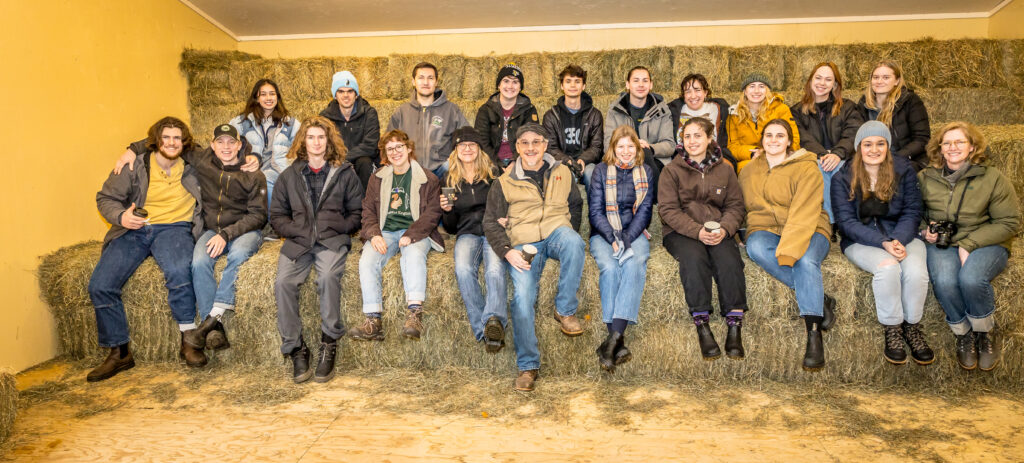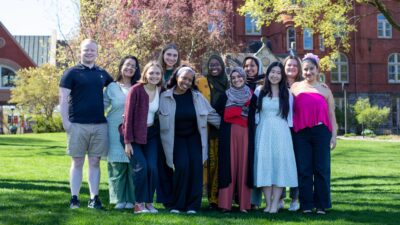
By Catherine Kane ’26
This spring, I am taking Professor Holly Barcus’s geography class Rural Landscapes and Livelihoods. It’s an exploration of the social, economic, and cultural trends in rural America. Throughout the course, we have discussed themes prevalent in many rural areas in the United States, including extractive economies, aging populations, race, political resentment, and gentrification. Our trip to the shores of Lake Superior in northeast Wisconsin was an opportunity to engage with community leaders and local residents on their perspective of the challenges and possibilities in rural spaces.
10 a.m. Arrived at Chickadee Hills Homestead in Spooner, Wisconsin. Chickadee Hills is a sustainable hog farm in rural Wisconsin. Sherry Sutton Zanardo, who runs the farm, talked to us about their efforts to have a completely organic farm, using existing flora and fauna to cultivate an entire ecosystem on their land. She also talked about her relationship with agri-tourism and wished tourism was exclusively the “icing on the cake” in the region.
10:45 a.m. Sherry brings us out to meet the animals! In addition to the Mangalista hogs, Chickadee Hills also has llamas and horses.
12 p.m. Stop at the Walmart in Hayward, Wisconsin, for snacks. We have talked about the economic and social role of Walmarts in rural America in class.
2:30 p.m. Arrive at the Northern Great Lakes Visitors Center. The Center is a collaboration of multiple state and federal agencies working to boost conservation and tourism in the area. Nonprofits and public agencies also use the center as a space for meetings. NGLVC also houses the historical archives of counties in Northern Wisconsin and we got to talk to the two archivists there about the various immigrant groups that have come through Northern Wisconsin. My mom’s family is from the Northwoods of Wisconsin and I found records of some of my family from over one hundred years ago!
5 p.m. Lenten season on a Friday in Northern Wisconsin calls for a fish fry. We stopped at Hugo’s Pizza in Ashland, Wisconsin, to enjoy fried fish, coleslaw, and rolls.
7:30 p.m. Arrived in Bayfield, where we will stay for the night. Bayfield is a very small town of around 550 people, but it supports a booming tourism industry. We explored the few blocks that encompass the town and ended the night with cheese curds at a local pub.
Saturday, 9 a.m. Our morning in Bayfield started with a continental hotel breakfast and roundtable discussion with local business owners in Bayfield. Curt Basnia, the owner and founder of Copper Crow Distillery, the first Native-owned distillery in the United States; Beta Bodin, a local business owner; and Carol Fahrenkrog, executive director of Bayfield Chamber of Commerce and Visitor Bureau, spoke of the benefits—and burdens—of tourism in the region. One of the most pressing issues is the small tax base having to support great usage of public infrastructure by tourists. Many of the topics discussed in the round table were ones we had also explored in the classroom back at Macalester.
11 a.m. Bayfield was hosting its annual Winter Festival so there were a lot of tourists milling about the town. We got the chance to explore the town for a few hours, luckily on a sunny and relatively warm day. I stopped in a bookstore, coffeeshop and local jewelry maker’s gallery. The themes that were discussed in the roundtable were evident while walking around town.
4 p.m. Arrived in Superior, Wisconsin to talk with Macalester geography alum Luke Matthews. Luke talked about his experience of moving to Superior, a small port city that stands in the shadow of Duluth. He talked about the city’s efforts to improve housing, transportation and land use. In class, we have discussed the trend of young people moving to rural areas during the pandemic because they wanted a lifestyle change and were seeking certain amenities. Hearing from someone who had taken that leap, and was a Mac alum, was a wonderful addition to our trip.
5 p.m. We crossed the canal into Duluth, Minnesota, to eat dinner and explore Canal Park. Most of the class landed at the same pizza restaurant where we enjoyed Neapolitan style pizza at a long table. A gorgeous sunset concluded our trip and we got back on the bus to come back to Macalester.
8:30 p.m. Back at Macalester! In the next week, we will write a short reflection on the trip and how it connects to the themes we are reading and talking about in class. The diversity of even just a fraction of the area we call “rural America” was amazing to see, and also serves as an example of how the broad categorization of people and land often causes us to miss the nuance and complexities of each community. And as a first-year in a class of mostly juniors and seniors, it was wonderful to spend time and get to know them better and hear about their college experiences and post-grad plans.

June 13 2023
Back to top




